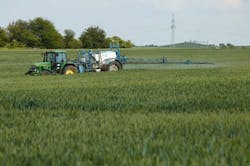Europe Assesses Pesticide Use
A 2017 report from the European Union’s European Food Safety Agency (EFSA), Parma, Italy, found that almost half of the food consumed on the continent contains pesticide residues.
[pullquote]
Of the 85,000 samples tested, 47% were found to contain such residues. The percentage of unprocessed food products with multiple pesticide residues ranged from dried hops (86.9%) and gooseberries (82.6%) to cherries (56.3%) and bananas (53.3%).
However, pointed out the EFSA scientists, only 2.8% exceeded the maximum residue levels permitted under European law and, even then, it didn’t mean the food was unsafe for consumption.
It’s an argument that doesn’t sit well with environmentalists and highlights one of the biggest challenges associated with the use of pesticides: i.e., understanding how their use can lead to a build-up of toxic and ecologically harmful residues in the soil.
Figure 1. Understanding the activity of pesticides in soils is key to their proper regulation. Source: UFZ/André Künzelmann.
A group of researchers from the Helmholtz Centre for Environmental Research (UFZ), Leipzig, Germany, working in partnership with colleagues from the Technical University of Denmark (DTU), Lyngby, Denmark, have developed a model that more accurately depicts the formation of potentially toxic residues.
The researchers are confident their model could be used in the future by the European Chemicals Agency (ECHA), Helsinki, Finland, for hazard assessment. The ECHA is the body charged with implementing chemicals legislation in the European Union.
The research focuses on breakdown products of pesticides known as non-extractable residues (NERs). These bind to soil particles and can build up in concentration. However, NERs can include a number of different chemicals, such as harmless bacterial biomass known as biogenic residues, or transformation products, known as toxic residues, that have a toxic effect and represent an environmental concern.
[callToAction ]
The challenge in the past has been to establish how these toxic residues vary from one pesticide to another.
“It’s important to know this to make the hazard assessment as realistic as possible,” says Matthias Kästner, an environmental biotechnologist at UFZ.
The model the researchers developed calculates the amount of biogenic residues initially formed in the soil by bacterial degradation processes. Subtracting these values from the total NER values — which are measured for all pesticides in the approval process — leaves only the toxicologically relevant residues.
“These are the residues that really matter,” Kästner says. “They often can’t be degraded any further by microorganisms, so they can be toxic and harmful to the soil.”
To create their model, the researchers analyzed the chemical structure of different pesticides to determine how difficult or easy soil bacteria broke them down and, in turn, how much energy could be extracted from them. The results of this analysis were then used to calculate the amount of microbial biomass that can potentially be produced from the degradation of the pesticide, and which remains in the soil in the form of harmless biogenic residues.
The biogenic residues of 40 different pesticides were modeled and then compared with the measured values used as part of the ECHA chemical approval process.
“It was very satisfying to see that our model calculations largely correlate with the actual measured values,” Kästner says. “This means that, based on the molecular properties, we can now assess in advance which pesticides are potentially biodegradable and what the likely amount of toxic residues is. There will no longer be need for time-consuming tests series.”
This isn’t the first time that UFZ and DTU have successfully modeled pesticide activity. Three years ago, in collaboration with scientists from the Rhine-Westphalian Technical University Aachen (RWTH), Aachen, Germany, they used radio-labeled carbon to develop a detection method and model that enabled the determination of how readily biodegradable the residues of pesticides are.
In that project, Kästner and his team applied pesticides onto various reference soils and examined them thoroughly regarding their fate. For this purpose, they initially marked the pesticide to be examined with the non-radioactive, heavy carbon isotope 13C — and tracked it in various biomolecules with the aid of a mass spectrometer after completion of the experiment timeframe. In this manner, the scientists were able to determine the residues, the changes in the pesticide, and its breakdown products in the soil.
The findings of this study were accepted into the assessment processes used by German food safety regulatory officials, and also laid the foundations for the latest research.


